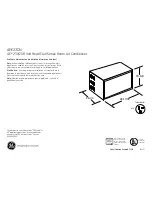
15
XIII. PRE-START CHECK
1. Is unit properly located and slightly slanted toward indoor
condensate drain?
2. Is ductwork insulated, weatherproofed, with proper spacing
to combustible materials?
3. Is air free to travel to and from outdoor coil? (See Figure
5.)
4. Is the wiring correct, tight, and according to unit wiring dia-
gram?
5. Is unit grounded?
6. Are field supplied air filters in place and clean?
7. Do the outdoor fan and indoor blower turn freely without
rubbing, and are they tight on the motor shafts?
XIV. STARTUP
1. Turn thermostat to “OFF,” turn “on” power supply at discon-
nect switch.
2. Turn temperature setting as high as it will go.
3. Turn fan switch to “ON.”
4. Indoor blower should run. Be sure it is running in the right
direction.
5. Turn fan switch to “AUTO.” Turn system switch to “COOL”
and turn temperature setting below room temperature. Unit
should run in cooling mode.
6. Is outdoor fan operating correctly in the right direction?
7. Is compressor running correctly.
Record the following after the unit has run some time.
A. Operating Mode _______________________________
B. Discharge Pressures (High) __________________PSIG
C. Vapor Pressure at Compressors (Low) _________PSIG
D.Vapor Line Temperature at Compressors °F.
E. Indoor Dry Bulb______________________________°F.
F. Indoor Wet Bulb _____________________________°F.
G. Outdoor Dry Bulb ____________________________°F.
H. Outdoor Wet Bulb ____________________________°F.
I. Voltage at Contactor ________________________Volts
J. Current at Contactors_______________________Amps
K. Model Number_________________________________
L. Serial Number _________________________________
M. Location______________________________________
N. Owner _______________________________________
O. Date_________________________________________
8. Turn thermostat system switch to “HEAT.” Unit compres-
sors should stop. Raise temperature setting to above room
temperature. Unit should run in heating mode and auxiliary
heaters, if installed, should come on.
9. Check the refrigerant charge using the instructions located
on unit charging chart. Replace service port caps. Service
port cores are for system access only and will leak if not
tightly capped.
10. Adjust discharge air grilles and balance system.
11. Check ducts for condensation and air leaks.
12. Check unit for tubing and sheet metal rattles.
13. Instruct the owner on operation and maintenance.
14. Leave “INSTALLATION” and ”USE AND CARE“ instruc-
tions with owner
XV.
OPERATION
COOLING MODE
With thermostat in the cool mode, fan auto and the room tem-
perature higher than the thermostat setting:
A. Indoor blower contactor is energized through thermostat
contact (G).
B. Compressor contactors are energized through thermostat
contacts (Y1) & (Y2) and high pressure controls.
C. Economizer enthalpy control (if installed) controls operation
of first-stage cooling and positions fresh air damper to main-
tain mixed air temperature. Second-stage cooling operates
normally as required by second stage of thermostats.
D. The system will continue in cooling operation as long as all
safety controls are closed, until the thermostat is satisfied.
HEATING MODE
With thermostat in the heat mode, fan auto and the room tem-
perature lower than the thermostat setting the indoor blower
contactor is energized through thermostat contact (G).
XVI. AUXILIARY HEAT
ONLY ELECTRIC HEATER KITS SUPPLIED BY THIS MAN-
UFACTURER AS DESCRIBED IN THIS PUBLICATION
HAVE BEEN DESIGNED, TESTED, AND EVALUATED BY A
NATIONALLY RECOGNIZED SAFETY TESTING AGENCY
FOR USE WITH THIS UNIT. USE OF ANY OTHER MANU-
FACTURED ELECTRIC HEATERS INSTALLED WITHIN
THIS UNIT MAY CAUSE HAZARDOUS CONDITIONS
RESULTING IN PROPERTY DAMAGE, FIRE, BODILY
INJURY OR DEATH.
In the heating mode, the thermostat will energize one or more
supplementary resistance heaters.
REPLACEMENT PARTS
Contact your local distributor for a complete parts list.
CHARGE INFORMATION
Refer to the appropriate charge chart on the unit, or in this
booklet.
TROUBLESHOOTING
Refer to the troubleshooting chart included in this manual.
WIRING DIAGRAMS
Refer to the appropriate wiring diagram included in this manual.
WARNING
!














































